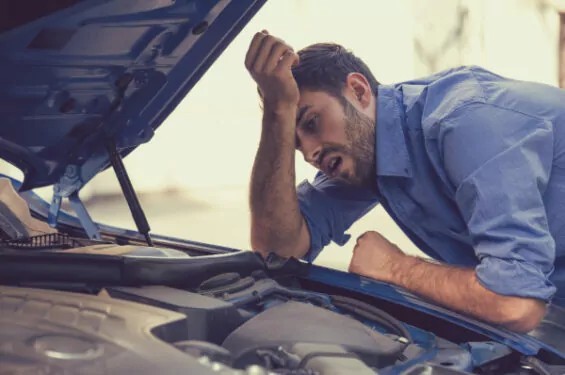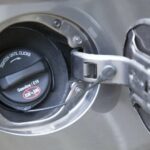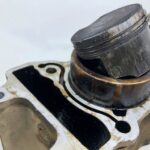It’s a moment every driver dreads. You turn the ignition key, maybe hear a worrying sputter or click, and then… silence. Whether you’re stranded in a grocery store parking lot, stuck in your driveway before a crucial meeting, or at a highway rest stop far from home, your car deciding not to start is never convenient. This frustrating situation often signals that your vehicle requires attention, ranging from a minor tweak to a significant repair. Even if it turns out to be a simple fix, a car that refuses to start can throw a major wrench into your day.
What to Do When Your Car Refuses to Start
Experiencing a car breakdown, especially on a busy road, can be a stressful and potentially dangerous situation. If you find yourself in this predicament and haven’t prepared a car emergency kit, there are immediate steps you should take. Your first action should be to contact roadside assistance to ensure both your safety and your vehicle’s safe relocation to a secure place, ideally an auto repair shop. Once safety is established, the next crucial step is to diagnose why your car is failing to start. Let’s explore the most common culprits behind a car that won’t start:
1. Dead Battery
The most frequent offender when your car won’t start is a dead or weak battery. While modern cars primarily run on gasoline or diesel, they are heavily reliant on electrical power for numerous functions. The starter motor, responsible for cranking the engine to life, needs a strong electrical surge to operate. If your battery is depleted or faulty, it simply can’t provide the necessary power to turn the engine over. While there are other telltale signs of a failing battery, such as dim headlights or slow cranking, checking if the engine attempts to turn over at all is a fundamental first diagnostic step.
The upside of a dead battery is that it’s often a problem you can address without professional help. Jump-starting a car battery is usually straightforward if you have jumper cables and access to another vehicle with a functioning battery. However, remember that jump-starting might only be a temporary fix. Repeated dead batteries can indicate an underlying issue, and battery replacement can be costly. Proactive battery maintenance is key to preventing these situations.
2. Faulty Alternator
A malfunctioning alternator is often the silent culprit behind a seemingly dead battery. The alternator’s primary job is to recharge the battery while the engine is running and to supply power to the car’s electrical systems after ignition. A failing alternator might not directly damage your battery initially, but it will prevent it from recharging, eventually leading to battery depletion and starting problems. A defective alternator requires replacement, and recognizing the warning signs of alternator trouble is crucial for preventative maintenance.
3. Clogged Fuel Filter
Fuel filters play a vital role in maintaining engine health by removing contaminants from the fuel before it reaches the engine. If a fuel filter becomes excessively clogged, it restricts fuel flow, hindering the combustion process necessary for starting and running your car. While it might seem obvious in retrospect, a blocked fuel filter is a common reason why a car struggles to start or won’t start at all.
Common Symptoms of a Clogged Fuel Filter
A clogged fuel filter can manifest in various fuel-related issues beyond just starting problems. You might notice a distinct gasoline odor, a noticeable decrease in fuel efficiency, engine hesitation during acceleration, and, crucially, difficulty starting the engine. Consult your car’s owner manual for the manufacturer’s recommended fuel filter replacement intervals. If your car is approaching this mileage or time mark, and you’re experiencing starting issues, inspecting and potentially replacing the fuel filter is a worthwhile step.
4. Defective Ignition Switch
The ignition switch is a critical intermediary component that bridges the battery and the starter motor. It acts as the electrical gateway, channeling power from the battery to engage the starter and initiate the engine starting sequence.
Common Symptoms of a Bad Ignition Switch
If the ignition switch is faulty, you’ll likely turn the key and hear absolutely nothing – no starter motor engagement, no engine cranking sounds. Furthermore, because the ignition switch also activates the car’s main electrical systems, you might observe electrical malfunctions such as flickering or dimming dashboard lights. In older cars with traditional key-turn ignitions, you might even encounter difficulty physically turning the key in the ignition cylinder.
5. Malfunctioning Starter Motor
While battery and alternator issues are frequent starting culprits, the starter motor itself can also fail. The starter motor is responsible for physically cranking the engine when it receives the electrical signal from the ignition system. If there’s an internal problem within the starter motor, or if it’s not receiving adequate power, your car might not respond when you turn the key.
Common Symptoms of a Bad Starter Motor
A simple way to initially check for a starter motor issue in key-ignition cars is to observe your dashboard lights when you turn the key to the “start” position. Turning the key engages the battery. If the lights illuminate normally, indicating battery power, but the engine doesn’t crank or you hear only a single click or a series of clicks without the engine turning over, the starter motor is a prime suspect. Repeatedly attempting to start a starter motor that has a blown internal fuse or another electrical fault can cause it to overheat and potentially emit smoke.
6. Worn Spark Plugs
If your car is refusing to start, especially if it’s been exhibiting other performance issues, the spark plugs might be the problem. Spark plugs are essential components of the combustion process, igniting the air-fuel mixture in the engine cylinders. Old, fouled, or damaged spark plugs can lead to a cascade of problems, including reduced fuel economy, sluggish acceleration, engine misfires (rough idling or sputtering), and difficulty starting the engine.
7. Failing Fuel Pump
The fuel pump, typically located inside the fuel tank, is responsible for delivering fuel from the tank to the engine’s combustion chamber at the required pressure. A failing fuel pump can struggle to supply sufficient fuel, leading to starting problems and other performance issues. If your “check engine” light is illuminated, you notice prolonged engine cranking before starting, or experience hesitation or power loss during acceleration, a fuel pump issue should be investigated.
8. Empty Fuel Tank (or Bad Fuel)
While seemingly obvious, an empty fuel tank is a surprisingly common reason for a car failing to start. If you’ve been pushing your fuel gauge to its limit, running out of gas is a distinct possibility. The good news is, this isn’t a mechanical problem with your car. The solution is simple: obtain a gas can, add a couple of gallons of fuel to your tank, and you should be able to start and drive to a gas station. Another fuel-related issue, although less common, is stale or contaminated fuel, particularly if the car has been sitting unused for an extended period.
9. Damaged Timing Belt
The timing belt is a critical internal engine component that ensures the synchronized rotation of the engine’s camshaft and crankshaft. This precise synchronization is essential for the engine valves to open and close at the correct times in relation to the pistons, enabling proper combustion.
Common Symptoms of a Bad Timing Belt
A failing or broken timing belt can produce several warning signs. You might hear unusual ticking or slapping noises emanating from the engine, experience erratic engine revving or misfires, or, in severe cases, the engine might not turn over at all when you attempt to start it. Timing belts are considered a routine maintenance item and have recommended replacement intervals. If you suspect a timing belt issue, consult a mechanic promptly, as a broken timing belt can cause significant engine damage.
10. Steering Wheel Lock
Have you ever gotten into your car and found you couldn’t even turn the ignition key? This is often due to a locked or jammed steering wheel. As an anti-theft feature, most cars have a steering wheel lock that engages when the wheel is moved without the ignition key inserted. Occasionally, this lock can engage unintentionally, preventing you from starting the car.
If your steering wheel is locked and preventing ignition, try gently but firmly wiggling the steering wheel left and right while simultaneously attempting to turn the ignition key. This maneuver usually disengages the lock, allowing you to turn the key and start the car normally.
11. Cracked Distributor Cap
While spark plugs are essential for ignition, the distributor cap plays a supporting role in older vehicles. The distributor cap’s function is to distribute high-voltage electrical pulses from the ignition coil to the correct spark plug in the engine’s firing order. A cracked, damp, or malfunctioning distributor cap can disrupt this process, leading to engine misfires, illumination of the “check engine” light, unusual engine noises, and, ultimately, starting problems. Inspect the distributor cap for cracks or moisture, and replace it if damage is evident. If you’re unfamiliar with distributor caps or ignition systems, it’s best to seek professional assistance.
12. Electrical System Issues
Beyond the battery and alternator, various other electrical issues can prevent a car from starting. These can range from problems within the fuse box (blown fuses interrupting power flow), to corroded battery terminals hindering electrical connection, or loose or damaged wiring in the starting circuit. A thorough inspection of the car’s electrical system, including fuses, wiring, and connections, is necessary to rule out these potential causes.
13. Faulty Immobilizer
Modern vehicles are often equipped with immobilizer systems as an anti-theft measure. The immobilizer is an electronic security system that prevents the engine from starting unless the correct key (or key fob) is present and transmits the correct security code. If your key fob battery is dead, or there’s a malfunction in the immobilizer system, it might fail to recognize your key, preventing the engine from starting. If you suspect an immobilizer issue, consulting your owner’s manual or a qualified technician is recommended.
Understanding the potential reasons why your car won’t start is the first step towards resolving the problem. However, proactive car maintenance is the most effective way to minimize the likelihood of starting issues and other breakdowns. Regular servicing, including battery checks, fuel filter replacements, and spark plug maintenance, can significantly enhance your car’s reliability.
For peace of mind on the road, consider the benefits of a comprehensive auto insurance policy. Many policies offer roadside assistance coverage, providing support when unexpected car troubles leave you stranded.
Sources:
[1] “Starting Problems? How to Tell if It’s the Battery or Alternator,” lesschwab.com/article/batteries/starting-problems-how-to-tell-if-its-the-battery-or-alternator.html (Accessed December 2024).
[2] “8 Signs You Need to Change Your Fuel Filter,” firestonecompleteautocare.com/blog/maintenance/clogged-fuel-filter-symptoms (Accessed December 2024)
[3] “Ignition Switch Problems: Signs, Causes, What to Do,” Richard McCuistian, carparts.com/blog/ignition-switch-problems-signs-causes-what-to-do (Accessed December 2024).
[4] “Car Won’t Start? 6 Signs of a Bad Starter,” firestonecompleteautocare.com/blog/maintenance/signs-of-a-bad-starter (Accessed December 2024).
[5] “Bad Spark Plug Symptoms,” firestonecompleteautocare.com/blog/maintenance/when-to-change-spark-plugs (Accessed December 2024).
[6] “Does My Car Need a New Fuel Pump?” kbb.com/car-advice/does-my-car-need-a-new-fuel-pump/ (Accessed December 2024).
[7] “Why Won’t My Car Start?” kbb.com/car-advice/why-wont-my-car-start/ (Accessed December 2024).
[8] “Signs of a Bad Timing Belt,” gillmanacura.com/signs-of-a-bad-timing-belt (Accessed December 2024).
[9] “Bad Distributor Cap: Symptoms, Testing, Replacement Cost,” carparts.com/blog/bad-distributor-cap-symptoms-testing-replacement-cost (Accessed December 2024).
[10] “Common Issues in Your Car’s Electrical System,” chandlerandsons.com/2024/03/21/common-issues-in-your-cars-electrical-system (Accessed December 2024).
[11] “What Is a Theft Device Immobilizer?” jdpower.com/cars/shopping-guides/what-is-a-theft-device-immobilizer (Accessed December 2024).
Disclaimer:
The information included is designed for informational purposes only. It is not legal, tax, financial or any other sort of advice, nor is it a substitute for such advice. The information may not apply to your specific situation. We have tried to make sure the information is accurate, but it could be outdated or even inaccurate in parts. It is the reader’s responsibility to comply with any applicable local, state, or federal regulations. Nationwide Mutual Insurance Company, its affiliates and their employees make no warranties about the information nor guarantee of results, and they assume no liability in connection with the information provided. Nationwide, Nationwide is on your side, and the Nationwide N and Eagle are services marks of Nationwide Mutual Insurance Company. © 2025 Nationwide.


